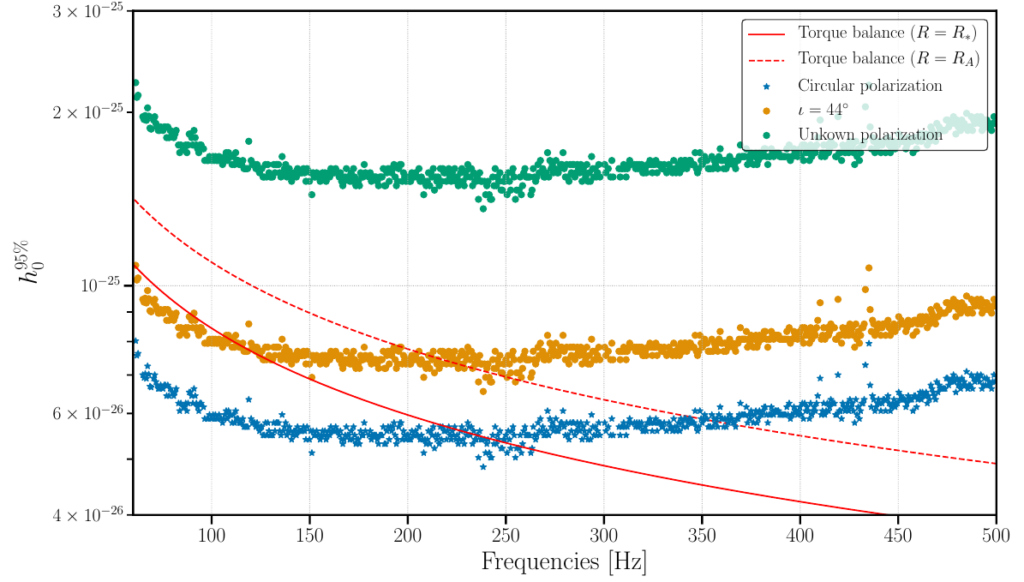What are we looking for?
The gravitational wave signals detected thus far by the LVK collaboration detectors arise from mergers of heavy astronomical objects, such as black holes or neutron stars. However, this is not the only type of gravitational waves that can be observed. A more elusive case involves the so-called continuous gravitational waves; these are gravitational waves which are being continuously emitted by a source. Continuous gravitational waves can open a new avenue on the path to understanding the universe. The problem is that these continuous signals are extremely weak — in order for those waves to be detected, searches need to combine data over long periods of time.
Promising sources of continuous gravitational waves include neutron stars, which are extremely dense, rapidly-rotating objects that generate extreme gravitational fields. Although there are various mechanisms via which a neutron star can generate such a continuous spectrum, a very simple one results from an asymmetry or bump in the neutron star crust. As the neutron star rotates, such a bump creates continuous gravitational waves, similar to a propeller generating waves in water.
Why is Scorpius X-1 an ideal source for continuous gravitational waves?
Scorpius X-1 is a low-mass X-ray binary (LMXB), i.e., a system composed of a neutron star in a binary orbit with a low-mass normal star, referred to as the companion. A characteristic property of these systems is the inflow of gas from the companion star to the neutron star, in a process known as accretion. The by-product of accretion is the generation of X-rays; the more accretion, the more X-rays are produced.

Figure 1: An artist’s impression of the Scorpius X-1 LMXB system. (Courtesy of Ralg Schoofs)
Since accretion can generate a bump in the neutron star, strong sources of X-rays are good candidates for continuous gravitational wave detection. Other than the Sun, Scorpius X-1 is the brightest source of X-rays in the sky, making it an ideal target for such a search. This is the reason why searches for continuous gravitational waves from Scorpius X-1 have been performed in previous observation runs, for instance in O1 (Interested? — see O1 hidden Markov model analysis, O1 CrossCorr analysis), and O2 (see O2 hidden Markov model analysis).
Nevertheless, searching for gravitational waves from Scorpius X-1 has its problems. First, gravitational waves are emitted at harmonics (multiples) of the star spin frequency and there are no measurements of the spinning frequency of the neutron star in Scorpius X-1. This implies that our search has to cover a broad frequency range to find a signal. Second, the chaotic nature of accretion implies that the spin frequency of the neutron star can change in an unpredictable way over time. This phenomenon is called spin wandering.
How did we search for continuous gravitational waves?
There are several methods to search for continuous gravitational waves from Scorpius X-1, for instance CrossCorr search, and Radiometer. However, to accommodate for the broad frequency range and the spin wandering we use a technique called hidden Markov model, which allows us to efficiently look for signals whose frequency changes slightly during the observation period. This technique relies on analyzing the data by dividing them into segments, each being ten-days-long, and then reconstructing the most likely frequency path of the continuous gravitational wave by connecting all the segments.
To correctly analyze each segment, a statistic, called the J-statistic, is used. This tool takes as input information about the binary, such as: how the orbit of the binary is oriented, the position of the neutron star in the binary, and the orbital period, and then converts the raw data from the detectors into the likelihood of a signal being present at a given frequency. An additional caveat of this search is that the measurements of these parameters remain imprecise. To improve sensitivity we use a grid of possible values for these parameters, similar to a fishing net, and try to capture the signal. To this end, this is the most exhaustive search ever performed using the hidden Markov model. It had to run on a supercomputer for approximately 6 months to finish!
Results and future perspective
No convincing evidence of continuous gravitational waves was found in this search on data from the third observing run (O3). Although several signal candidates were observed, the most probable explanation for those are fluctuations in the background detector noise that mimic real signals.
From this analysis we were able to set upper limits on the signal, i.e., estimate the signal amplitude that would have been detected in this search if the signal had been present. This was the first time the hidden Markov model was used to search for signals that are, for a given frequency range, within the maximum theoretical estimates for detection. These estimates are denoted as the solid red line in Figure 2, whereas our upper limits are denoted by the dotted marks.

Figure 2 (figure 4 in the publication; click for a larger version): the upper limits established by this search on the amplitude of the signal (vertical axis) as a function of the searched frequency (horizontal axis). The green dots represent the upper limits without any assumption regarding the orbit’s inclination angle, the orange dots represent the upper limits assuming an orbit inclination angle of 44 degrees while the blue stars represent the circular polarized case (a zero degree inclination angle). The red lines (dashed and solid) show the theoretical estimates of the gravitational wave strain assuming ideal conditions.
With this level of sensitivity, we are entering an uncharted territory. Surely the next observation run, O4, involving more sensitive detectors and longer data intake, will bring novel exciting results for the search of continuous gravitational waves from Scorpius X-1!
Find out more
- Visit our websites:
- Read a free preprint of the full scientific article here or on arXiv.org

